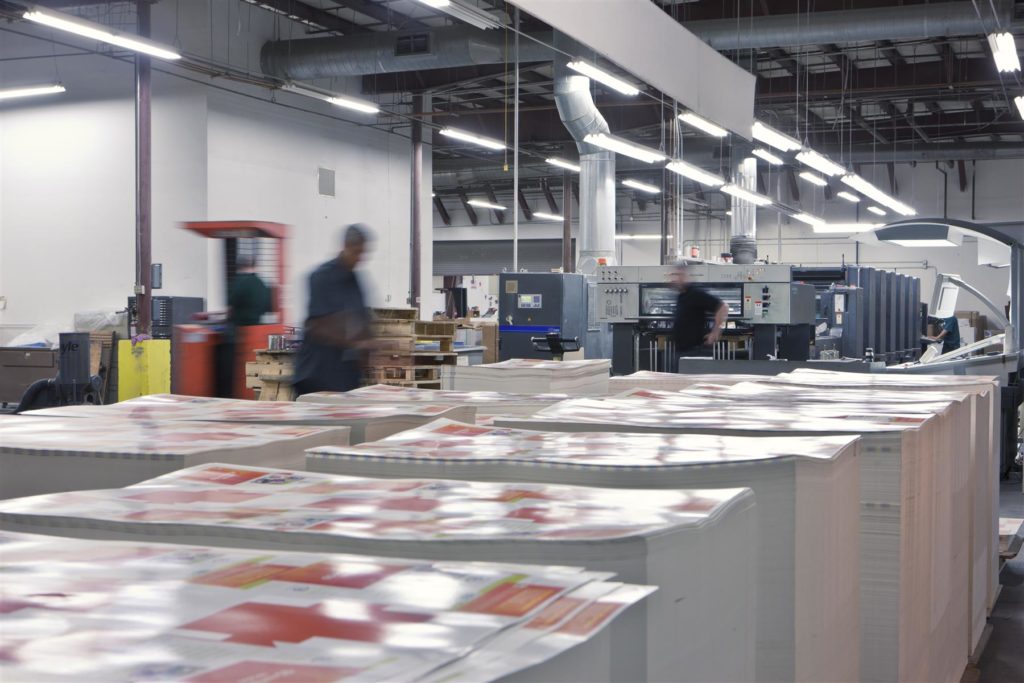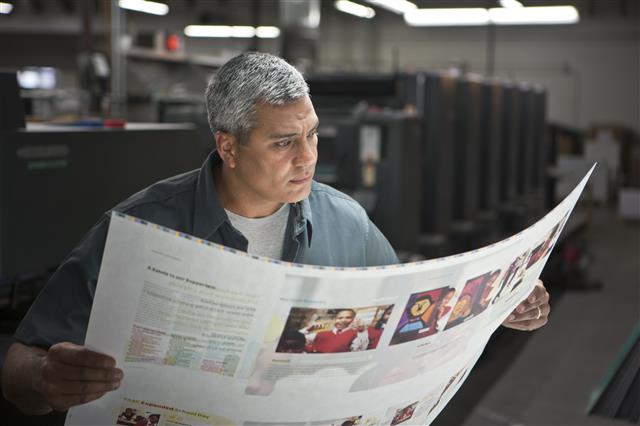[As someone interested in production inkjet printing, you’ll want to watch this blog for upcoming posts sharing ideas from thought leaders at the Xerox INKjet-setters Summit 2018. We promise more good information for your inkjet journey, but for now, you’ll have plenty to get you started with these resources below.]
Production inkjet technology is attractive to printers for many reasons, but it’s a serious decision to make. The full benefits of inkjet are best achieved through careful research and consideration. Use the resources we’ve collected here to make your inkjet journey faster and smoother.
1. White Paper: “The Value of Cut-sheet Inkjet”
Don’t fear disruption. Instead, get in the zone — “The Zone of Disruption.” Keypoint Intelligence says this is where you find inkjet’s high speeds, low running costs and acquisition prices lower than roll-fed color inkjet systems.
For some operations, a cut-sheet color inkjet press can be the ideal entre into the zone of production disruption. This InfoTrends (now Keypoint Intelligence) white paper explains the value of cut-sheet inkjet and takes a look at one such system. It also describes key applications for inkjet in the production color market.
Read this white paper to learn more about the advantages inkjet brings to cut-sheet applications:
- Flexibility and running costs
- Assuring consistent quality
- Trends and opportunities
2. White Paper: “The Inkjet Opportunity”
In a nutshell, this is what’s fueling inkjet growth:
- Inkjet lowers costs.
- Inkjet boosts productivity.
- Inkjet opens up new applications.
How much thought have you given to the production inkjet printing opportunity? Inkjet meets needs that offset and other traditional technologies can’t, by producing high volumes of variable content at low cost. That’s such a strong driver that 58% of all digital production color volume will be printed on inkjet devices by 2019, according to some reports. The question is, how much of that business will be yours? Are you prepared to transform your operation to reduce costs and grow new revenue streams?

Production inkjet transforms your print operations by driving out costs in multiple ways:
- Forms elimination by white paper-in printing
- Equipment consolidation and optimization
- Optimized job mix
- Workflow efficiency
Spend time with this white paper as you plan how to bring the benefits of cost-effective inkjet printing to more of your work.
3. Guide: “Understanding the Total Cost of Ownership of an Inkjet Press”
Don’t let lack of knowledge hold you back from making an important decision about your future in inkjet. With any large purchase, researching your options and asking peers and vendors the right questions are the first steps to an informed decision.
This popular handbook helps printers understand the pros and cons of different inkjet press options. It provides insights on total cost of ownership for your particular set of applications. Use this guide to uncover the hidden expenses lurking beneath the surface of inkjet ownership. When you better understand these factors, you’ll know what inkjet investment makes the most sense for you:

- Capital equipment costs
- Service contracts
- Variable charges
- Consumables
- Substrates
- Operator costs
- Facility and site preparation costs
- Production considerations
After spending some time with this guide, you’ll have the basic information and key considerations that go into purchasing an inkjet press.
4. Blog: “12 Questions to Ask About Inkjet Press Total Cost of Ownership”
As you move through the process of evaluating inkjet, don’t assume you’ve got all the data you’ll need for the best decision. Dig beneath the surface to where other factors lurk. Press buyers need a different information set about total cost of inkjet ownership (TCO). If you don’t, your inkjet decision may not turn out the way you’d hoped.
Use these suggestions to guide your inkjet conversations:
- Start with the basics. Ask potential press providers how they measure the TCO of their inkjet presses?
- How much will installation cost? Sometimes this gets buried.
- Ask for a sample book of inkjet output at varying Image Quality (IQ) levels, ink drop sizes and resolutions.
- Will installation require changes to your building’s infrastructure? Every facility is unique, so there’s no standard answer for this one.
Questions like the ones listed here help lead you to a realistic TCO for inkjet printing. That way you can build a growth plan without getting blindsided by pricing surprises and hidden fees.
5. Blog: “Seven Considerations When Comparing Toner and Inkjet”
For many years, Howie Fenton has helped in-plants and commercial printers benchmark their operational and financial performance. He also makes recommendations to increase productivity, reduce costs and increase value. In this blog, he offers seven considerations for printers considering inkjet over toner.
One tip is to pay attention to finishing. “In-line finishing is a good strategy if you’re producing one or two types of application sizes consistently. However, jams in the in-line finishing equipment also reduce the utilization rate of the entire production line,” cautions Fenton.

Printers should also consider how they save by eliminating their preprinted shell strategy (purchasing pages preprinted on offset, then overprinting on a toner device.) The alternative is a “white paper factory” strategy, which eliminates costs associated with buying and storing the shells.
Many transactional in-plants today have fleets of toner-based machines that could be replaced by a smaller number of inkjet production machines. For high-volume transactional printers, the transition to inkjet has become a critical issue as current leases expire. These shops have to weigh continuing with the same equipment or investing in inkjet. This head-to-head comparison of toner-based to inkjet-based digital presses explores some subtle factors that make the comparison tricky.
6. Blog: “How Inkjet and In-Line Finishing Impact Book Production Costs”
InfoTrends (now Keypoint Intelligence) reports that production color digital book printing accounted for 16.7 billion impressions in 2013 and expects up to 52.3 billion impressions in 2018. Interestingly, of those billions of impressions, almost 90% will come from production inkjet systems.
Book printers have been affected by declining run lengths and the need to cost-effectively handle these shorter runs. While offset printing is faster once underway, it’s more costly at startup because of plate production, proofing and paper waste. Volume has to be enough to balance out the more costly set up associated with offset. As a result, shorter runs are driving many book printers to look at digital and inkjet production presses, especially with in-line finishing.
Cost-per-page is relatively easy to calculate when based strictly on printing costs. However, total cost-per-book is more complicated. An interesting crossover chart in this blog calculates cost-per-page or total cost-per-book based on run lengths across inkjet, toner and offset. Automation in any printing or finishing technologies further reduces manufacturing costs. Some predict that shifting shorter run books moved from offset to inkjet will also result in about a 50% reduction in waste. It’s worth learning more about.
7. Video Case Study: “With Inkjet Press, Datagraphic Remains a Strategic Leader in Data Management and Printing”
UK-based strategic document outsourcer Datagraphic produces time-sensitive customer and employee communications. By embracing a multichannel service delivery model, Datagraphic has significantly increased its print volumes over the past decade, and inkjet production lets Datagraphic produce jobs at very high speeds within tight windows.
Watch the video to see how the Xerox Rialto 900 press helps Datagraphic:
- Print 3X the volume of conventional laser printer, with just one operator
- Offer versioned print as a differentiator
- Deliver duplex color printing faster for transactional documents
8. Case study: “Henry Wurst, Inc., Sees Best ROI with Xerox Rialto 900 Inkjet Press”
Henry Wurst, Inc. is an established commercial printer and marketing services provider, with web, sheet-fed and digital production, as well as digital media delivery. They produce around 84 million digital pages annually. Henry Wurst saw an opportunity to enhance their offerings while radically improving both efficiency and profit margins, and that opportunity was inkjet. Why not? Inkjet production is associated with simple operation, setup and maintenance; reduced operating costs; and increased pages and revenue.
“We’ve gained new customers and seen an increase in the size of our transactional projects because we have an option for high-speed digital color reproduction and can now compete for higher volume personalized color documents,” declared the company’s Prepress & Digital Production Manager.
Learn how inkjet helps Henry Wurst print more work faster with a smaller footprint. The compact, high-speed, color inkjet press proves its value with results that let Henry Wurst:
- Compete for higher-volume personalized color documents with competitive pricing.
- Reproduce readable 3-4 point reverse type, unlike most offset and toner devices.
- Increase production capacity by 10% out of the gate with a dual stacker.




[…] Most print providers looking at inkjet for the first time face a technology migration involving either moving or consolidating volume from offset or cut-sheet Xerographic devices. But business transformation means more than just replacing a printer. In addition to the obvious differences between each technology in handling ink, media and color management, inkjet migration opportunities present unique operational considerations. Your technology advisories and vendor partners can help you work through the key questions. You’ll also find resources for your inkjet journey in this blog, […]